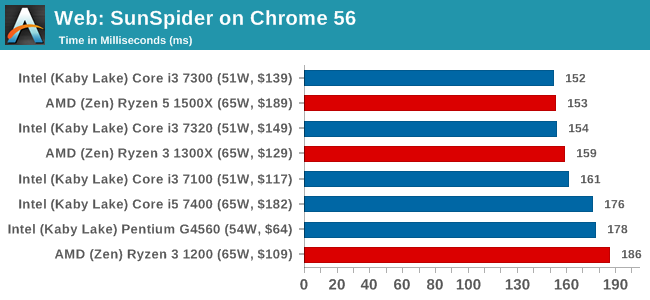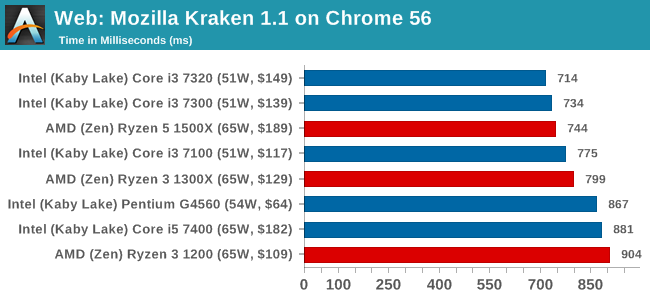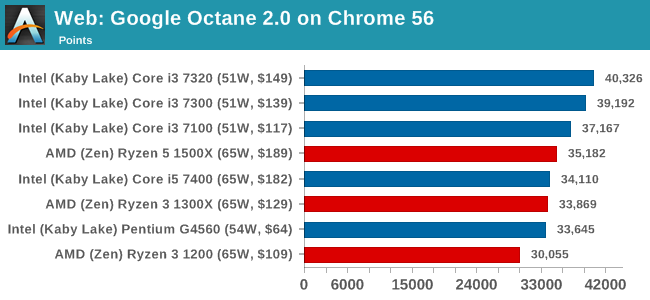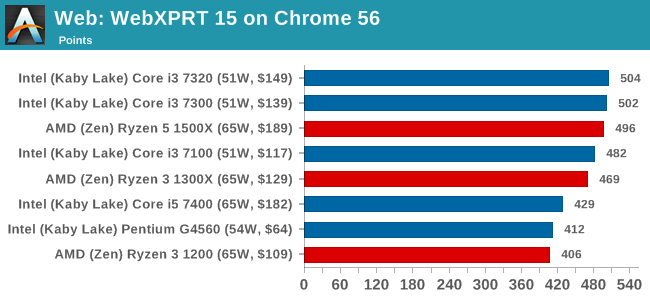The AMD Ryzen 3 1300X and Ryzen 3 1200 CPU Review: Zen on a Budget
by Ian Cutress on July 27, 2017 9:30 AM EST- Posted in
- CPUs
- AMD
- Zen
- Ryzen
- Ryzen 3
- Ryzen 3 1300X
- Ryzen 3 1200
Benchmarking Performance: CPU Web Tests
One of the issues when running web-based tests is the nature of modern browsers to automatically install updates. This means any sustained period of benchmarking will invariably fall foul of the 'it's updated beyond the state of comparison' rule, especially when browsers will update if you give them half a second to think about it. Despite this, we were able to find a series of commands to create an un-updatable version of Chrome 56 for our 2017 test suite. While this means we might not be on the bleeding edge of the latest browser, it makes the scores between CPUs comparable.
All of our benchmark results can also be found in our benchmark engine, Bench.
SunSpider 1.0.2: link
The oldest web-based benchmark in this portion of our test is SunSpider. This is a very basic javascript algorithm tool, and ends up being more a measure of IPC and latency than anything else, with most high-performance CPUs scoring around about the same. The basic test is looped 10 times and the average taken. We run the basic test 4 times.

Mozilla Kraken 1.1: link
Kraken is another Javascript based benchmark, using the same test harness as SunSpider, but focusing on more stringent real-world use cases and libraries, such as audio processing and image filters. Again, the basic test is looped ten times, and we run the basic test four times.

Google Octane 2.0: link
Along with Mozilla, as Google is a major browser developer, having peak JS performance is typically a critical asset when comparing against the other OS developers. In the same way that SunSpider is a very early JS benchmark, and Kraken is a bit newer, Octane aims to be more relevant to real workloads, especially in power constrained devices such as smartphones and tablets.

WebXPRT 2015: link
While the previous three benchmarks do calculations in the background and represent a score, WebXPRT is designed to be a better interpretation of visual workloads that a professional user might have, such as browser based applications, graphing, image editing, sort/analysis, scientific analysis and financial tools.











140 Comments
View All Comments
dave_the_nerd - Thursday, July 27, 2017 - link
Yes, obviously. That would be terrible.Oxford Guy - Thursday, July 27, 2017 - link
I'm glad you're not a tech reviewer. You could just say "Obviously" for every technical detail and that would be your article.Gothmoth - Thursday, July 27, 2017 - link
you can overclock the cheap AMD cpus... what about the intels?i am to lazy to check but are the testets intels k models? i guess not.
ddhelmet - Friday, July 28, 2017 - link
One thing I am really curious about is Citra performance. It would be an important test for single thread performance. All about that IPC.serendip - Friday, July 28, 2017 - link
Sorry but I don't see the point of these chips. An i3 is supposed to be a cheap do-everything CPU for basic business and school PCs. The Ryzen 3 not having a GPU really hurts its chances in those segments and it probably won't get picked up by OEMs. AMD needs mass market sales right now and Ryzen APUs can't come soon enough.I'm also wondering if yields are good enough that Ryzen 7s are the main chips being produced, with few 5s and 3s left over from the 7s that didn't meet spec.
Outlander_04 - Saturday, July 29, 2017 - link
The core count of the Ryzen chips is going to be a significant advantage over any dual core .Adding a basic graphics card will cost about $30 . For that you free up system RAM that the onboard would otherwise be using, and you get decent drivers that let you make some adjustments that intel removed when they dumbed down their drivers a few years back
serendip - Saturday, July 29, 2017 - link
Yeah but most office tasks run fine on 2 cores. Most users probably won't even notice they're using quad core processor.That $30 extra is a lot when it comes to speccing thousands of machines. A cheap discrete GPU is also another potential point of failure that large enterprises might not want on a big rollout. I understand the enthusiast reasoning for a cheap but powerful CPU like the Ryzen 3 paired with a decent midrange card, but this setup doesn't make sense for large corporate orders. AMD needs to sell lots of chips to large clients to survive.
Outlander_04 - Saturday, July 29, 2017 - link
It's not just the "Office tasks". Its the network services, antivirus and updating that goes on in what should be the background, but is not when you have a dual-core. I speak from experience. The HP desktops we have at work can be frustrating.buxe2quec - Friday, July 28, 2017 - link
Posting a review with placeholders for the benchmarks is definitely not professional.Delay it two days and post it in full, or split it in two reviews.
Looks like clickbaiting...
supdawgwtfd - Friday, July 28, 2017 - link
Ian. Your a shill. Or you just completely biased.Every single other review i have read has said the Ryzen 3 it the better option. In price and performance.
WTF has happened to Anandtech? Why are you guys spewing BS? Why can't you be unbiased?
Seriously?
Have been reading the site for almost 20 years. I think i will now have to officially NOT come here again...